*NURSING > HESI MED SURG > Med Surg Final Exam Study Guide |MSN 5410 With Latest Updated Version (All)
Med Surg Final Exam Study Guide |MSN 5410 With Latest Updated Version
Document Content and Description Below
MSN 5410 Med Surg Final Exam Study Guide (Chapters used in this Review- 6, 8, 11-16, 23, 26, 31-38, 40-51, 56-72, 74) (Chapters Before Midterm 11-40, 54-60/After Midterm 6, 41-48,50-51, 53-60, 62-... 74) Coronary Artery Bypass Graft Surgery- Ch6, Ch33, Ch34, Ch38 1. A nurse assesses a client recovering from coronary artery bypass graft surgery. Which assessment should the nurse complete to evaluate the clients activity tolerance? a. Vital signs before, during, and after activity b. Body image and self-care abilities c. Ability to use assistive or adaptive devices d. Clients electrocardiography readings ANS: A To see whether a client is tolerating activity, vital signs are measured before, during, and after the activity. If the client is not tolerating activity, heart rate may increase more than 20 beats/min, blood pressure may increase over 20 mm Hg, and vital signs will not return to baseline within 5 minutes after the activity. A body image assessment is not necessary before basic activities are performed. Self-care abilities and ability to use assistive or adaptive devices is an important assessment when planning rehabilitation activities, but will not provide essential information about the clients activity tolerance. Electrocardiography is not used to monitor clients in a rehabilitation setting. 2. A nurse prepares a client for coronary artery bypass graft surgery. The client states, I am afraid I might die. How should the nurse respond? a. This is a routine surgery and the risk of death is very low. b. Would you like to speak with a chaplain prior to surgery? c. Tell me more about your concerns about the surgery. d. What support systems do you have to assist you? ANS: C The nurse should discuss the clients feelings and concerns related to the surgery. The nurse should not provide false hope or push the clients concerns off on the chaplain. The nurse should address support systems after addressing the clients current issue. 3. A nurse is assessing clients on a medical-surgical unit. Which client should the nurse identify as being at greatest risk for atrial fibrillation? a. A 45-year-old who takes an aspirin daily b. A 50-year-old who is post coronary artery bypass graft surgery c. A 78-year-old who had a carotid endarterectomy d. An 80-year-old with chronic obstructive pulmonary disease ANS: B Atrial fibrillation occurs commonly in clients with cardiac disease and is a common occurrence after coronary artery bypass graft surgery. The other conditions do not place these clients at higher risk for atrial fibrillation. 4. A nurse is in charge of the coronary intensive care unit. Which client should the nurse see first? a. Client on a nitroglycerin infusion at 5 mcg/min, not titrated in the last 4 hours b. Client who is 1 day post coronary artery bypass graft, blood pressure 180/100 mm Hg c. Client who is 1 day post percutaneous coronary intervention, going home this morning d. Client who is 2 days post coronary artery bypass graft, became dizzy this a.m. while walking ANS: B Hypertension after coronary artery bypass graft surgery can be dangerous because it puts too much pressure on the suture lines and can cause bleeding. The charge nurse should see this client first. The client who became dizzy earlier should be seen next. The client on the nitroglycerin drip is stable. The client going home can wait until the other clients are cared for. Activity Tolerance/Angina- Ch6 5. A nurse teaches a client with a past history of angina who has had a total knee replacement. Which statement should the nurse include in this clients teaching prior to beginning rehabilitation activities? a. Use analgesics before and after activity, even if you are not experiencing pain. b. Let me know if you start to experience shortness of breath, chest pain, or fatigue. c. Do not take your prescribed beta blocker until after you exercise with physical therapy. d. If you experience knee pain, ask the physical therapist to reschedule your therapy. ANS: B Participation in exercise may increase myocardial oxygen demand beyond the ability of the coronary circulation to deliver enough oxygen to meet the increased need. The nurse must determine the clients ability to tolerate different activity levels. Asking the client to notify the nurse if symptoms of shortness of breath, chest pain, or fatigue occur will assist the nurse in developing an appropriate cardiac rehabilitation plan. Ambulation/Older Adult- Ch6 6. A nurse delegates the ambulation of an older adult client to an unlicensed nursing assistant (UAP). Which statement should the nurse include when delegating this task? a. The client has skid-proof socks, so there is no need to use your gait belt. b. Teach the client how to use the walker while you are ambulating up the hall. c. Sit the client on the edge of the bed with legs dangling before ambulating. d. Ask the client if pain medication is needed before you walk the client in the hall. ANS: C Before the client gets out of bed, have the client sit on the bed with legs dangling on the side. This will enhance safety for the client. A gait belt should be used for all clients. The UAP cannot teach the client to use a walker or assess the clients pain. 7. A nurse assists a client with left-sided weakness to walk with a cane. What is the correct order of steps for gait training with a cane? 1. Apply a transfer belt around the clients waist. 2. Move the cane and left leg forward at the same time. 3. Guide the client to a standing position. 4. Move the right leg one step forward. 5. Place the cane in the clients right hand. 6. Check balance and repeat the sequence. a. 3, 1, 5, 4, 2, 6 b. 1, 3, 5, 2, 4, 6 c. 5, 3, 1, 2, 4, 6 d. 3, 5, 1, 4, 2, 6 ANS: B To ambulate a client with a cane, the nurse should first apply a transfer belt around the clients waist, then guide the client to a standing position and place the cane in the clients strong hand. Next the nurse should assist the client to move the cane and weaker leg forward together. Then move the stronger leg forward and check balance before repeating the sequence. Spinal Cord Injury/Cred Bladder- Ch6 8. A nurse is caring for a client who has a spinal cord injury at level T3. Which intervention should the nurse implement to assist with bladder dysfunction? a. Insert an indwelling urinary catheter. b. Stroke the medial aspect of the thigh. c. Use the Cred maneuver every 3 hours. d. Apply a Texas catheter with a leg bag. ANS: C Two techniques are used to facilitate voiding in a client with a flaccid bladder: the Valsalva maneuver and the Cred maneuver. Indwelling urinary catheters generally are not used because of the increased incidence of urinary tract infection. Stroking the medial aspect of the thigh facilitates voiding in clients with upper motor neuron problems. If the spinal cord injury is above T12, the client is unaware of a full bladder and does not void or is incontinent. Therefore, the client would not benefit from a Texas catheter with a leg bag. Airborne Precautions/TB-Ch8, Ch23 9. While triaging clients in a crowded emergency department, a nurse assesses a client who presents with symptoms of tuberculosis. Which action should the nurse take first? a. Apply oxygen via nasal cannula. b. Administer intravenous 0.9% saline solution. c. Transfer the client to a negative-pressure room. d. Obtain a sputum culture and sensitivity. ANS: C A client with signs and symptoms of tuberculosis or other airborne pathogens should be placed in a negative- pressure room to prevent contamination of staff, clients, and family members in the crowded emergency department. 10. A client is being admitted with suspected tuberculosis (TB). What actions by the nurse are best? (Select all that apply.) a. Admit the client to a negative-airflow room. b. Maintain a distance of 3 feet from the client at all times. c. Order specialized masks/respirators for caregiving. d. Other than wearing gloves, no special actions are needed. e. Wash hands with chlorhexidine after providing care. ANS: A, C A client with suspected TB is admitted to Airborne Precautions, which includes a negative-airflow room and special N95 or PAPR masks to be worn when providing care. A 3-foot distance is required for Droplet Precautions. Chlorhexidine is used for clients with a high risk of infection. Vascular Access Device-Ch13 11. A nurse delegates care to an unlicensed assistive personnel (UAP). Which statement should the nurse include when delegating hygiene for a client who has a vascular access device? a. Provide a bed bath instead of letting the client take a shower. b. Use sterile technique when changing the dressing. c. Disconnect the intravenous fluid tubing prior to the clients bath. d. Use a plastic bag to cover the extremity with the device. ANS: D The nurse should ask the UAP to cover the extremity with the vascular access device with a plastic bag or wrap to keep the dressing and site dry. The client may take a shower with a vascular device. The nurse should disconnect IV fluid tubing prior to the bath and change the dressing using sterile technique if necessary. These options are not appropriate to delegate to the UAP. 12.A nurse teaches a client who is prescribed a central vascular access device. Which statement should the nurse include in this clients teaching? a. You will need to wear a sling on your arm while the device is in place. b. There is no risk of infection because sterile technique will be used during insertion. c. Ask all providers to vigorously clean the connections prior to accessing the device. d. You will not be able to take a bath with this vascular access device. ANS: C Clients should be actively engaged in the prevention of catheter-related bloodstream infections and taught to remind all providers to perform hand hygiene and vigorously clean connections prior to accessing the device. The other statements are incorrect. 13.A nurse is caring for a client with a peripheral vascular access device who is experiencing pain, redness, and swelling at the site. After removing the device, which action should the nurse take to relieve pain? a. Administer topical lidocaine to the site. b. Place warm compresses on the site. c. Administer prescribed oral pain medication. d. Massage the site with scented oils. ANS: B At the first sign of phlebitis, the catheter should be removed and warm compresses used to relieve pain. The other options are not appropriate for this type of pain. 14.A nurse assists with the insertion of a central vascular access device. Which actions should the nurse ensure are completed to prevent a catheter-related bloodstream infection? (Select all that apply.) a. Include a review for the need of the device each day in the clients plan of care. b. Remind the provider to perform hand hygiene prior to starting the procedure. c. Cleanse the preferred site with alcohol and let it dry completely before insertion. d. Ask everyone in the room to wear a surgical mask during the procedure. e. Plan to complete a sterile dressing change on the device every day. ANS: A, B, D The central vascular access device bundle to prevent catheter-related bloodstream infections includes using a checklist during insertion, performing hand hygiene before inserting the catheter and anytime someone touches the catheter, using chlorhexidine to disinfect the skin at the site of insertion, using preferred sites, and reviewing the need for the catheter every day. The practitioner who inserts the device should wear sterile gloves, gown and mask, and anyone in the room should wear a mask. A sterile dressing change should be completed per organizational policy, usually every 7 days and as needed. Chest Injury-Ch32 15.A client has been brought to the emergency department with a life-threatening chest injury. What action by the nurse takes priority? a. Apply oxygen at 100%. b. Assess the respiratory rate. c. Ensure a patent airway. d. Start two large-bore IV lines. ANS: C The priority for any chest trauma client is airway, breathing, circulation. The nurse first ensures the client has a patent airway. Assessing respiratory rate and applying oxygen are next, followed by inserting IVs. 16. A client is brought to the emergency department after sustaining injuries in a severe car crash. The clients chest wall does not appear to be moving normally with respirations, oxygen saturation is 82%, and the client is cyanotic. What action by the nurse is the priority? a. Administer oxygen and reassess. b. Auscultate the clients lung sounds. c. Facilitate a portable chest x-ray. d. Prepare to assist with intubation. ANS: D This client has manifestations of flail chest and, with the other signs, needs to be intubated and mechanically ventilated immediately. The nurse does not have time to administer oxygen and wait to reassess, or to listen to lung sounds. A chest x-ray will be taken after the client is intubated. Cardiac Murmur/Aortic Regurgitation- Ch33 17. A nurse assesses a client who has aortic regurgitation. In which location in the illustration shown below should the nurse auscultate to best hear a cardiac murmur related to aortic regurgitation? a. Location A b. Location B c. Location C d. Location D ANS: A The aortic valve is auscultated in the second intercostal space just to the right of the sternum. Ventricular Tachycardia-Ch34 18. A nurse assesses a clients electrocardiograph tracing and observes that not all QRS complexes are preceded by a P wave. [Show More]
Last updated: 1 year ago
Preview 1 out of 81 pages

Reviews( 0 )
Document information
Connected school, study & course
About the document
Uploaded On
Jun 14, 2021
Number of pages
81
Written in
Additional information
This document has been written for:
Uploaded
Jun 14, 2021
Downloads
0
Views
48


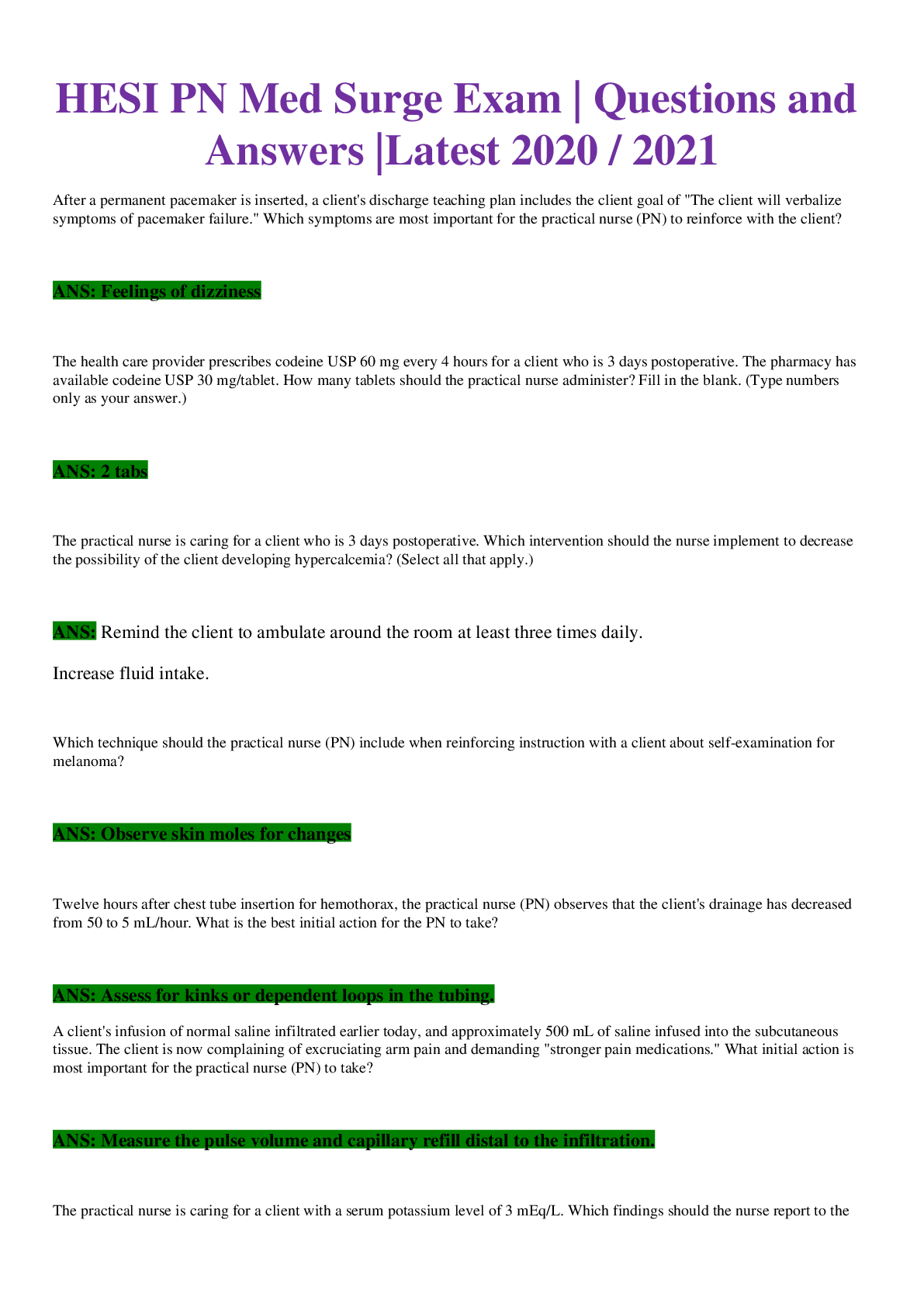

 Test Bank.png)
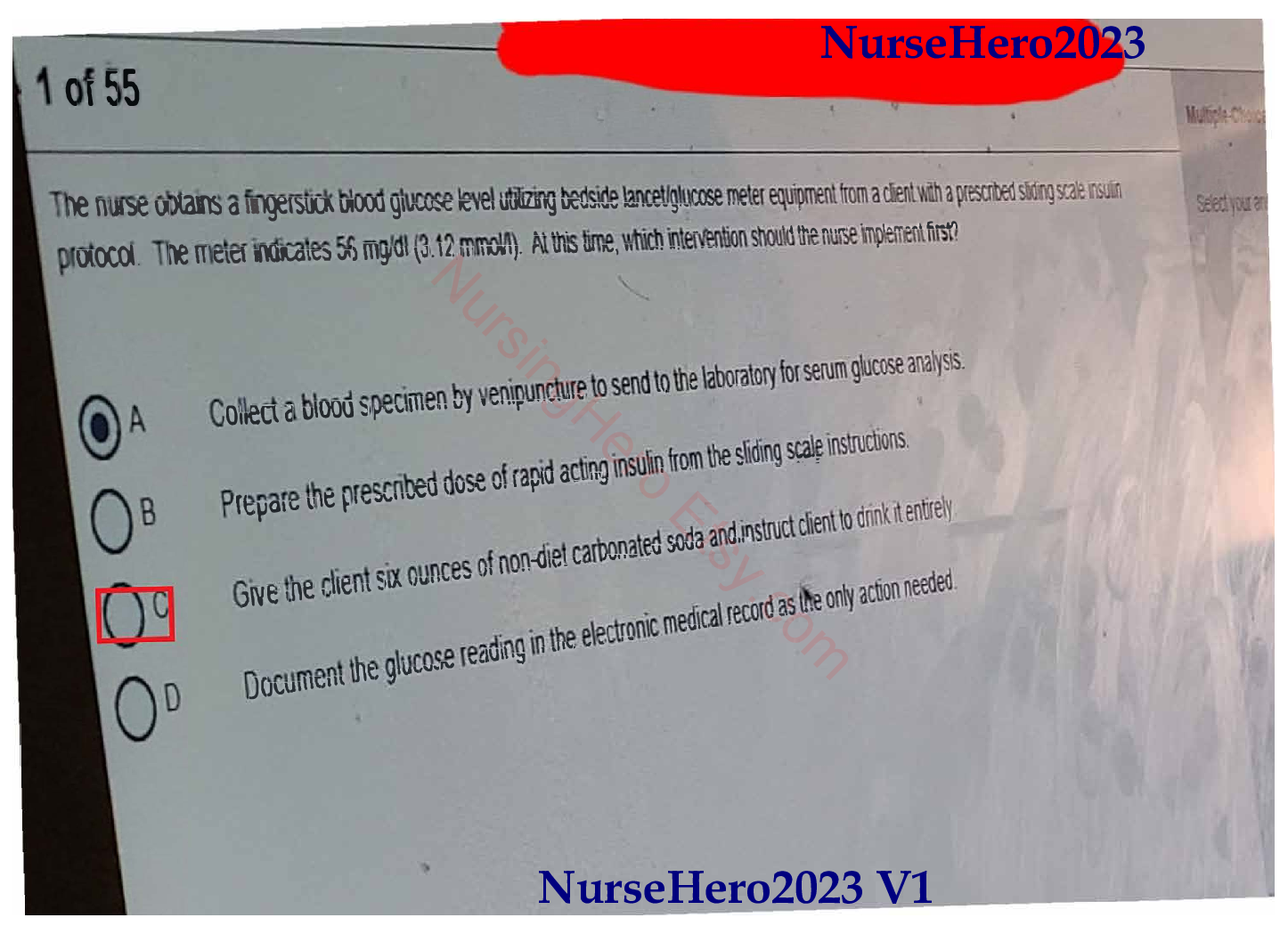

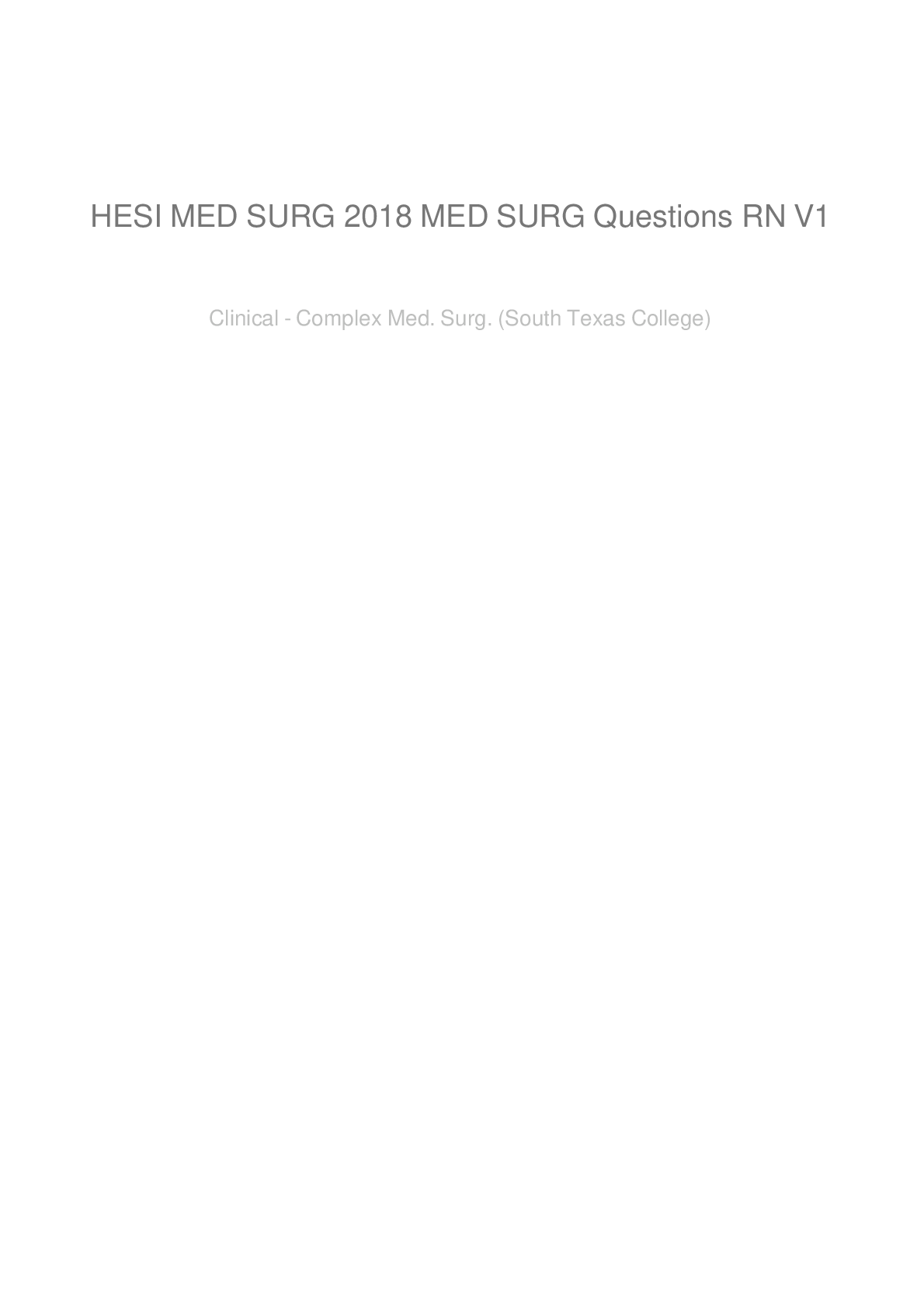
.png)
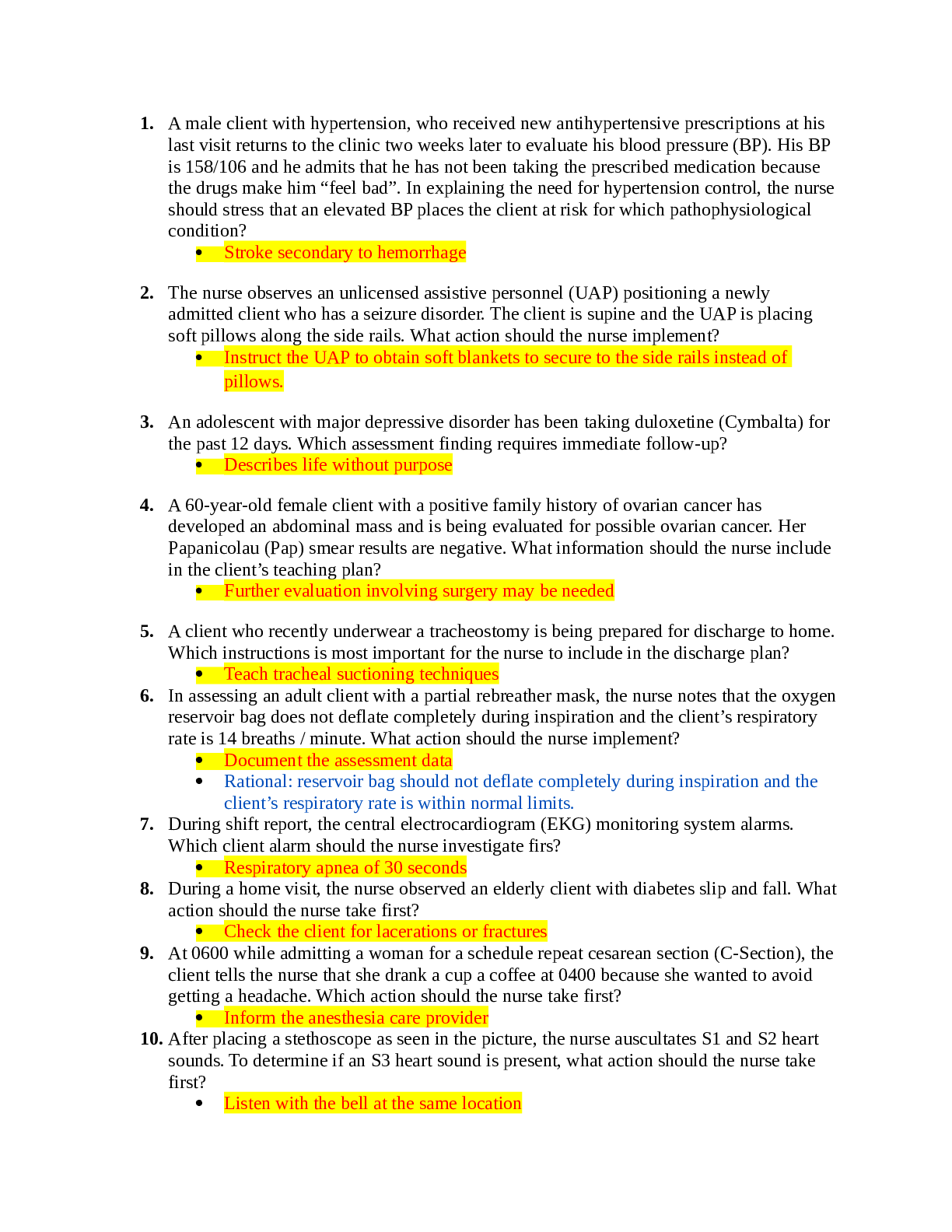
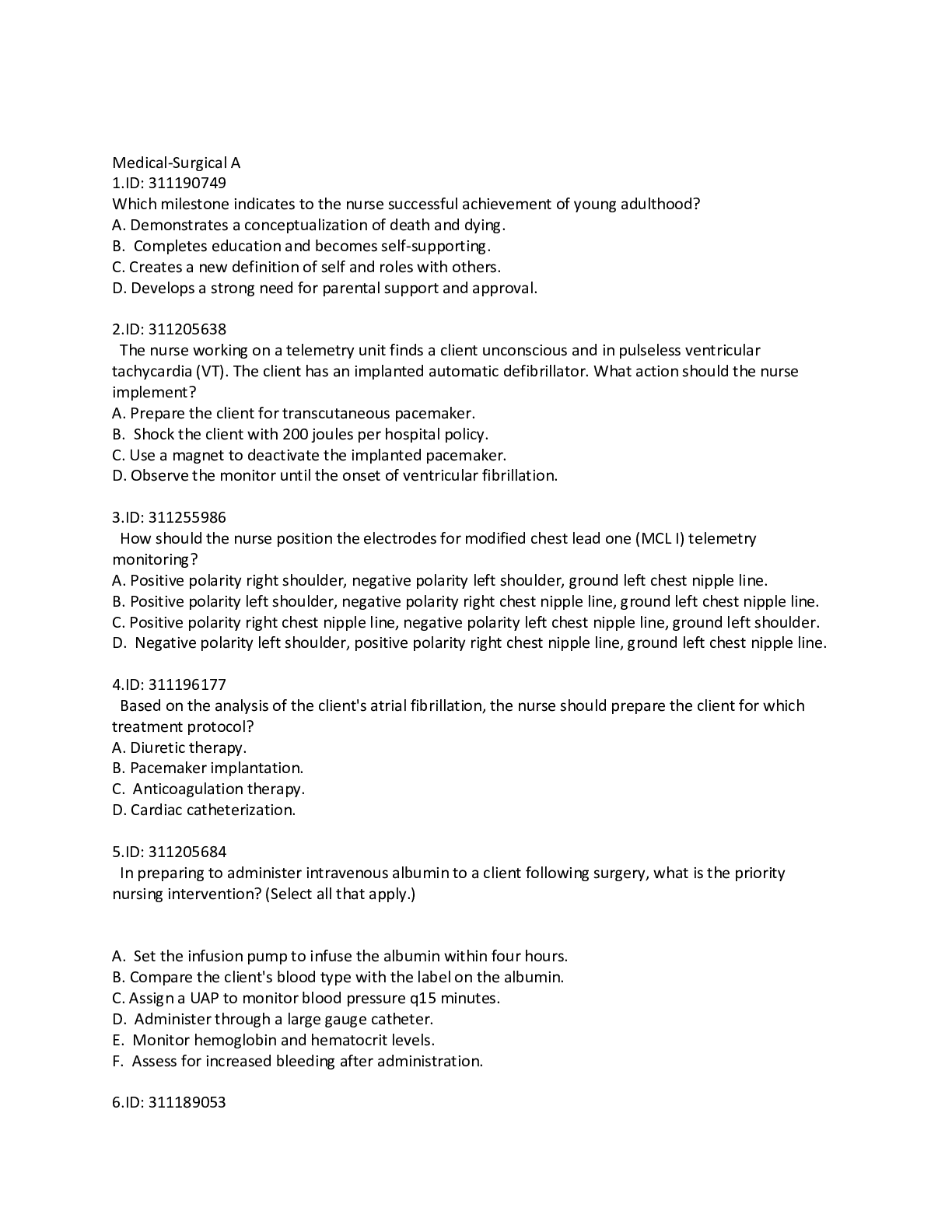
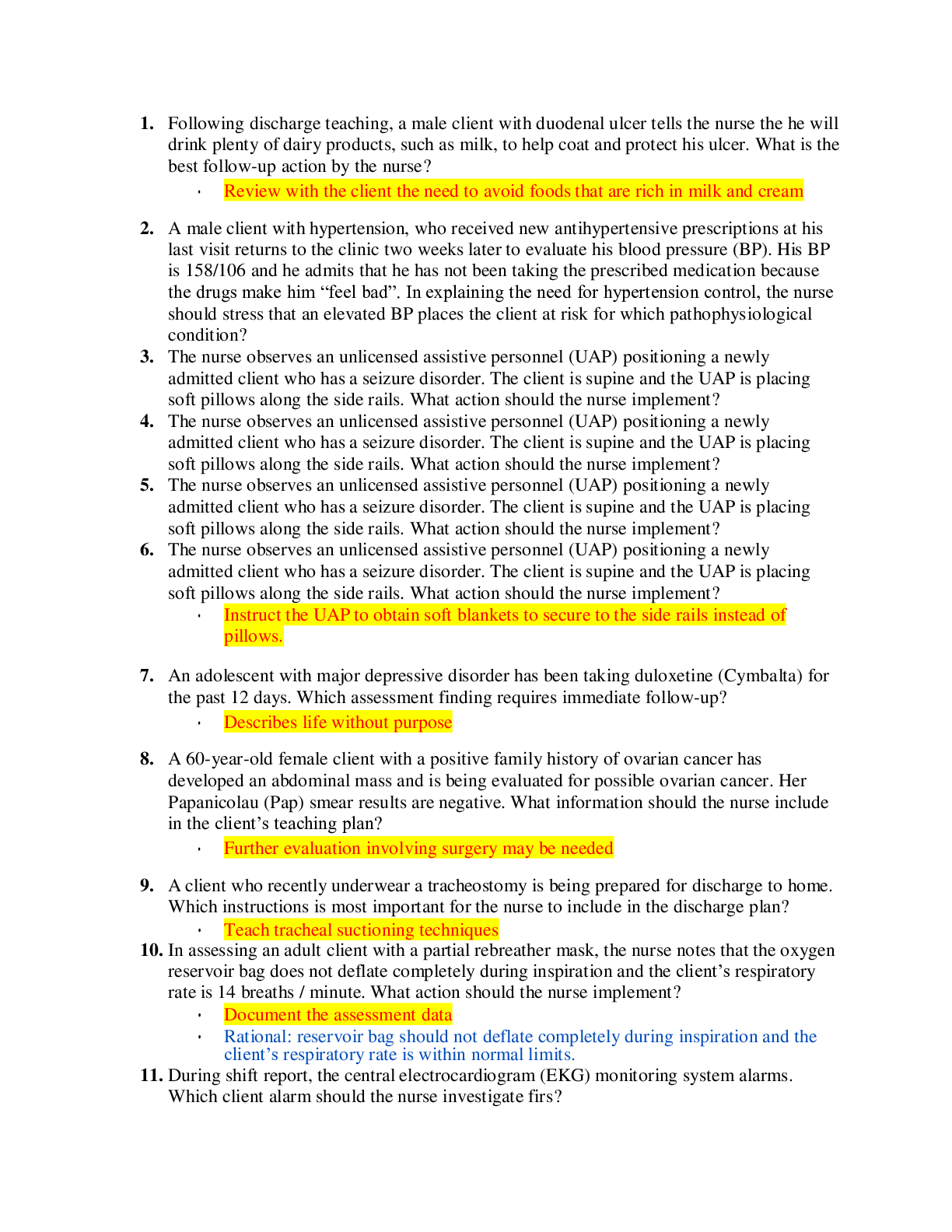


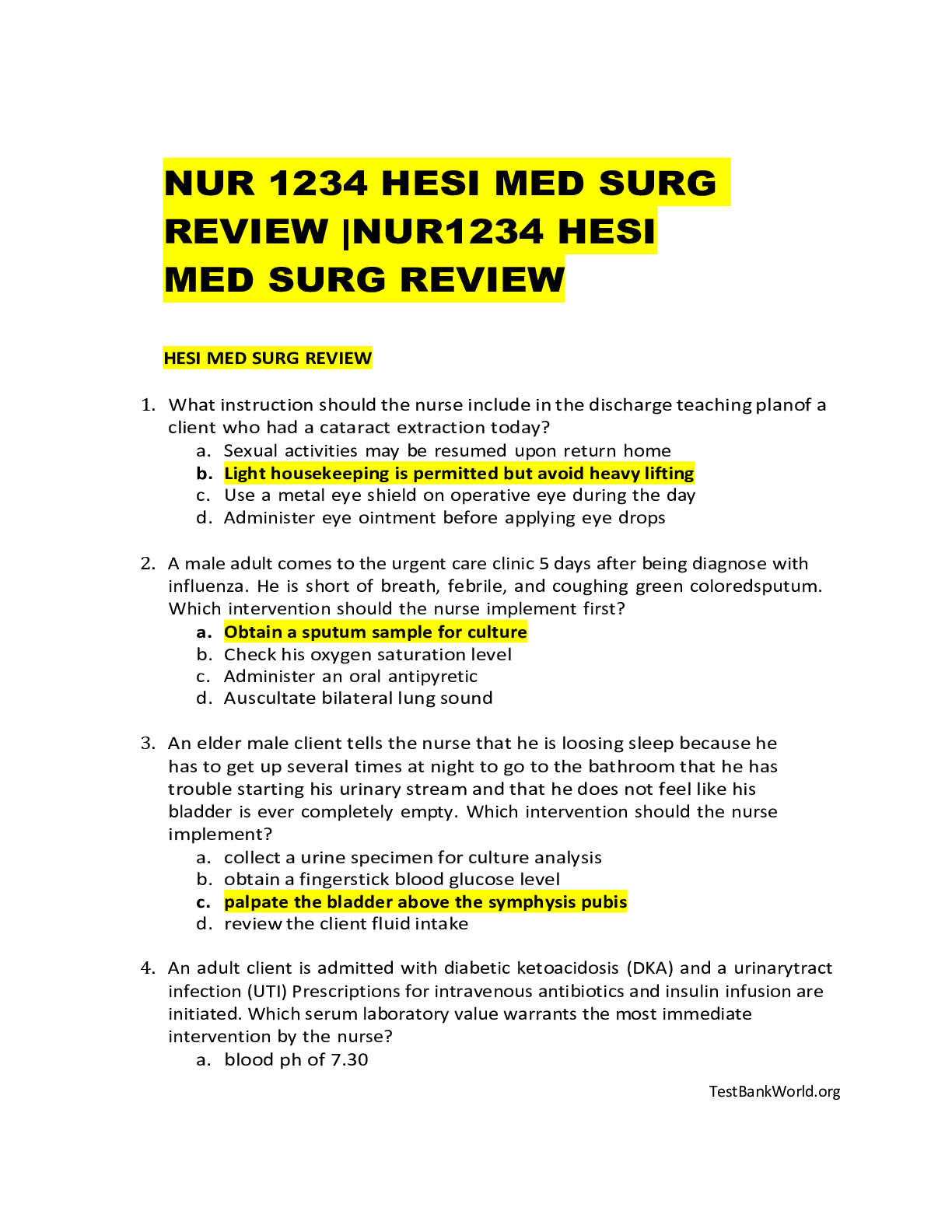
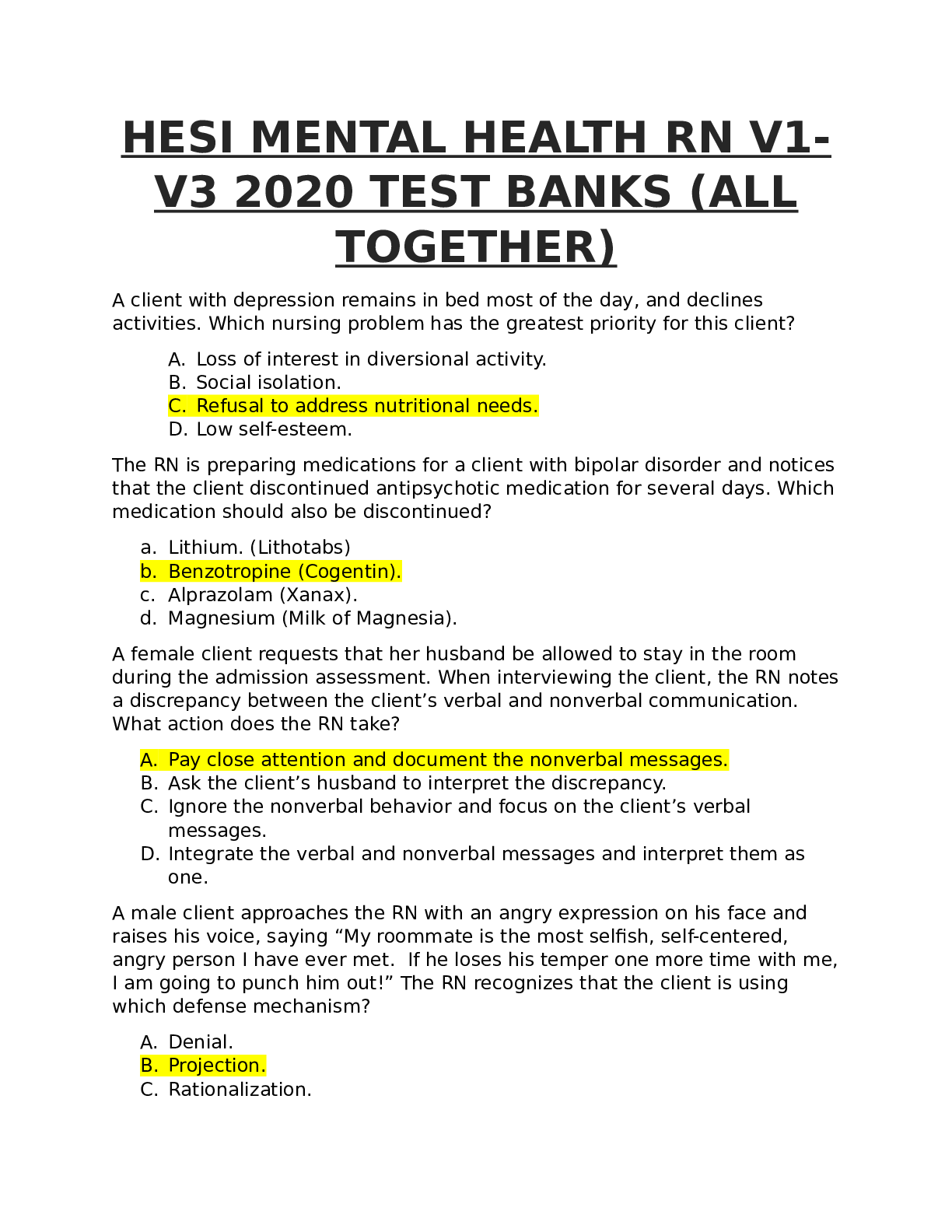
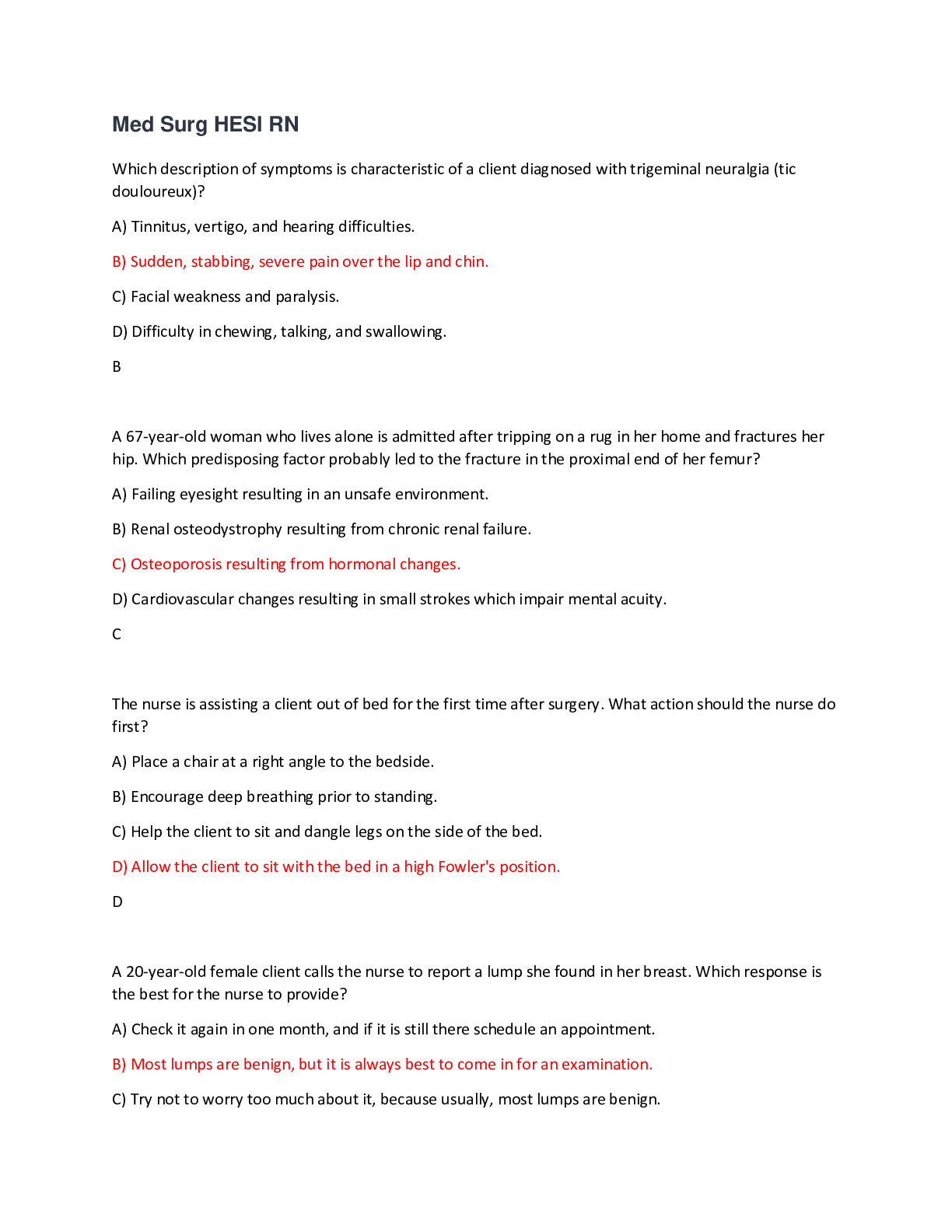
 Correct Study Guide, Download to Score A.png)
.png)


 Correct Study Guide, Download to Score A.png)

